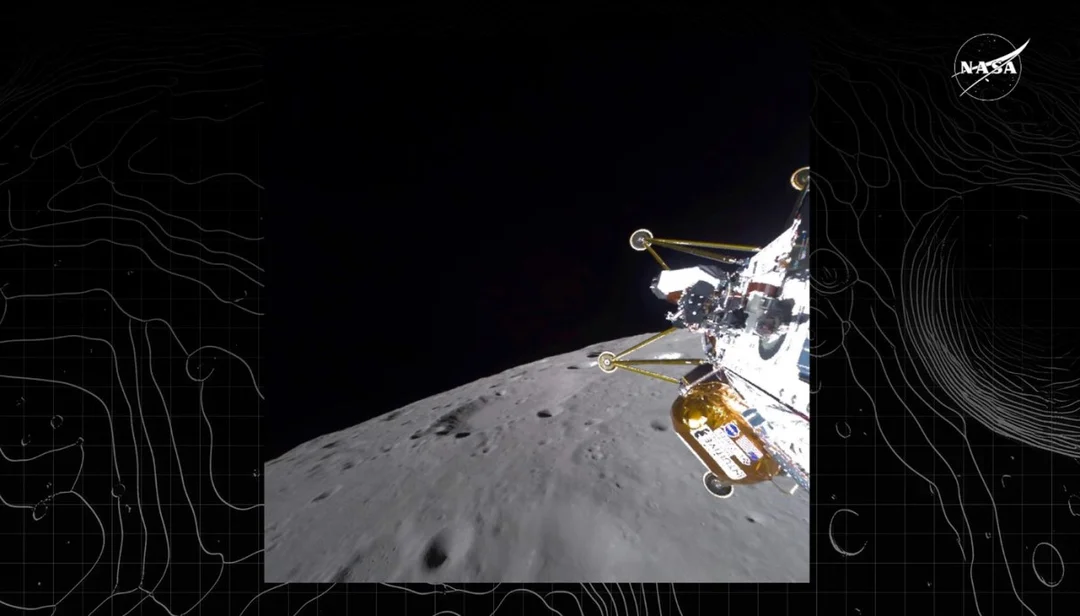
Intuitive Machines Pinpoints Causes of IM-2 Lunar Landing Failure, Eyes 2026 Redemption
Intuitive Machines, the company behind the private Athena lunar lander (IM-2), has identified the factors that led to its toppling on the moon's surface earlier this year. This revelation comes as the company sets its sights on a successful landing in 2026 with the IM-3 mission. The insights gained from the IM-2 mission, despite its challenges, are proving invaluable for future lunar endeavors.

The IM-2 mission, which aimed for a landing near the lunar south pole, experienced a mishap on March 6, 2025, when the Athena lander fell onto its side. This unfortunate event hampered the mission's objectives, as the lander's solar panels couldn't efficiently capture sunlight, leading to its early demise. Following a thorough post-mission review, Intuitive Machines CEO Steve Altemus highlighted three primary issues contributing to the landing failure:
- Laser Altimeter Interference: Signal noise and distortion disrupted accurate altitude readings during the final descent phase.
- Challenging Lighting Conditions: The South Pole's topography and low-angle sunlight created long shadows and dim lighting, hindering the precision of the landing system.
- Crater Recognition Limitations: The optical navigation system, relying on imagery from NASA's Lunar Reconnaissance Orbiter (LRO) at a 100 km altitude, couldn't accurately depict crater appearances at lower altitudes under South Pole lighting.
"We saw signal noise and distortion that did not allow for accurate altitude readings," Altemus explained. "South Pole topography and low-angle sunlight created long shadows and dim lighting conditions that challenged the precision capability of our landing systems."
Despite the setback, the IM-2 mission provided critical data. As Lunar Outpost's chief strategy officer, Forrest Meyen, stated about the MAPP rover, which was unable to deploy after the landing: "We got data on the way to the moon...It stayed connected to the lander and transmitted data for 2.7 hours.”
To prevent similar incidents on future missions, Intuitive Machines is implementing several enhancements. These include:
- Adding dissimilar and redundant altimeters to the sensor suite with more rigorous testing.
- Incorporating an additional lighting-independent sensor for surface velocity measurements.
- Expanding the onboard terrain crater database for enhanced navigation.
Furthermore, the detailed imagery collected during IM-2 is being fed into machine-learning algorithms to improve crater tracking and navigation performance in extreme conditions. "We've added dissimilar and redundant altimeters to the sensor suite and they're going through more rigorous and extreme flight-like testing than we've done before," Altemus explained.

The IM-3 mission, slated for the first half of 2026, represents Intuitive Machines' next shot at lunar success. This mission, under a NASA Commercial Lunar Payload Services (CLPS) program contract valued at $77.5 million, will carry four NASA science payloads to Reiner Gamma on the Moon. Among these payloads are small rovers designed to study magnetic fields and capture 3D imagery of the lunar surface.
Looking ahead, Intuitive Machines is also vying for NASA's Lunar Terrain Vehicle (LTV) program. Altemus expressed confidence that this ambition continues to proceed despite Artemis program changes with the Space Launch System rocket, Orion and Gateway.
The challenges faced during the IM-2 mission have provided invaluable lessons for Intuitive Machines. By addressing the identified issues and incorporating advanced technologies, the company is determined to achieve a successful and upright landing on the Moon in 2026, paving the way for continued lunar exploration and scientific discovery.
What do you think about the future of private lunar missions? Will Intuitive Machines be successful with IM-3? Share your thoughts in the comments below!